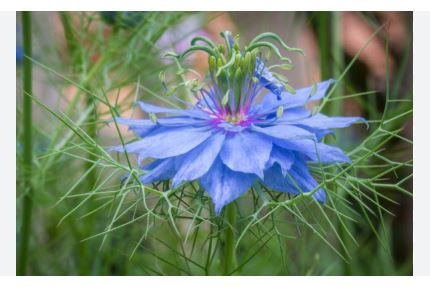
Nigella damascena, commonly known as love-in-a-mist, belongs to the Ranunculaceae (buttercup) family, a genus of about 18 annual species. The genus name Nigella derives from the Latin niger, meaning “black,” referring to its dark seeds, while damascena points to its association with Damascus, Syria.
As a true annual, it completes its life cycle in one growing season, self-seeding readily. It is botanically distinct from Nigella sativa (black cumin), a related species used for culinary seeds, though both share the same family and similar seed characteristics.
Love-in-a-mist grows 15–24 inches tall and up to 12 inches wide, with erect, sparingly branched stems and finely divided, thread-like, bright green leaves resembling fennel, creating a lacy “mist.” Its flowers, 1–1.5 inches across, feature five petal-like sepals in shades of blue, white, pink, or lavender, surrounding smaller, hidden petals and numerous stamens. The distinctive, inflated seed pods, up to 2 inches long, are green with purple or bronze stripes, topped with horn-like styles, and contain small, black, angular seeds.
Known since Elizabethan times, Nigella damascena has been a staple in English cottage gardens for its delicate beauty. Its seeds were historically used as a spice, condiment, or medicinal remedy (e.g., for headaches or as an expectorant), though less flavorful than N. sativa.
The plant’s romantic name, love-in-a-mist, reflects its ethereal appearance, while alternative names like “devil-in-the-bush” or “ragged lady” nod to its spiky seed pods and wild charm. Its ornamental use in dried arrangements dates back centuries.
Native to southern Europe, North Africa, and southwest Asia, Nigella damascena thrives in Mediterranean climates, often found in neglected, damp fields or rocky wastelands. It has naturalized in northern Europe and is widely cultivated in temperate regions, including North America and parts of Asia (e.g., northern China). In the U.S., it occasionally escapes cultivation but rarely persists long-term, appearing in meadows or waste areas. Its adaptability to various soils enhances its global garden popularity.
Love-in-a-mist is prized in cottage gardens, mixed borders, or containers for its airy foliage and jewel-like flowers. It’s ideal for filling gaps, edging, or mass planting, often paired with silver-leaved plants like dusty miller or spring bulbs to mask fading foliage. Both fresh flowers and dried seed pods are popular in floral arrangements, adding texture and color.
The plant attracts bees, supporting pollinators, and its self-seeding nature ensures recurring blooms. Seeds have minor culinary use, with a peppery-oregano flavor, but are less potent than N. sativa.
Nigella damascena, or love-in-a-mist, thrives in habitats with full sun to partial shade and well-drained, moderately fertile soils, tolerating a wide pH range from slightly acidic to neutral. Native to Mediterranean climates of southern Europe, North Africa, and southwest Asia, it naturally grows in open, sunny fields, rocky slopes, or disturbed areas like roadsides and abandoned lands.
It prefers temperate conditions, withstanding light frost (USDA Zones 4–9), and flourishes in areas with mild summers and adequate moisture, though it tolerates drought once established. Its self-seeding nature allows it to colonize garden beds or naturalize in meadows, making it adaptable to various garden settings.

Cultivars
Cultivars: Notable Nigella damascena cultivars include:
- ‘Miss Jekyll’ (soft blue, semi-double, 18 inches, RHS Award of Garden Merit)
- ‘Miss Jekyll Alba’ (pure white, semi-double, 12–18 inches, RHS Award)
- ‘Persian Jewels’ (mixed lavender, blue, pink, white, 18 inches)
- ‘Mulberry Rose’ (deep pink, 18–24 inches)
- ‘Oxford Blue’ (large, deep blue, extra-double, 30 inches)
- ‘Albion’ (white or pale shades, 18 inches)
- ‘Moody Blues’ (mixed blue shades, 18–24 inches)
- ‘Delft Blue’ (blue-splashed white petals, 18–24 inches)
- ‘Persian Rose’ (pale pink, 18 inches)
- ‘Dwarf Moody Blue’ (violet to sky blue, compact, 6–8 inches)
- ‘Midnight’ (velvety blue, 50 cm)
- ‘N. d. var. plena’ (double white or blue, 15 inches)
Cultivation of Nigella (Love-in-a-Mist)
- Plant Type: Nigella damascena is an annual, completing its life cycle in one season, self-seeding for future growth.
- Hardiness Zones: Thrives in USDA Zones 4–9, tolerating light frost but preferring temperate climates.
- Sunlight: Prefers full sun (6+ hours daily) but tolerates partial shade, especially in hotter regions.
- Soil: Grows best in well-drained, moderately fertile soil with a pH of 6.0–7.5; tolerates poor soils.
- Sowing Time: Direct sow seeds in early spring (March–April) or fall for earlier blooms in mild climates.
- Sowing Method: Scatter seeds on prepared soil, cover lightly with 1/8-inch soil, and space 2–3 inches apart.
- Germination: Seeds germinate in 10–15 days at soil temperatures of 60–65°F (15–18°C).
- Watering: Keep soil evenly moist during germination and early growth; established plants tolerate some drought.
- Thinning: Thin seedlings to 6–9 inches apart to promote airflow and reduce competition.
- Fertilizer: Minimal feeding needed; apply a balanced, water-soluble fertilizer (10-10-10) once at planting if soil is poor.
- Bloom Time: Flowers appear 8–10 weeks after sowing, typically June–August, lasting several weeks.
- Maintenance: Deadhead to prolong blooming or leave seed pods for ornamental use and self-seeding.
- Pests/Diseases: Generally pest-resistant; watch for aphids or powdery mildew in humid conditions; ensure good drainage.